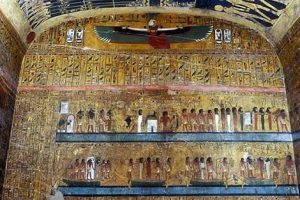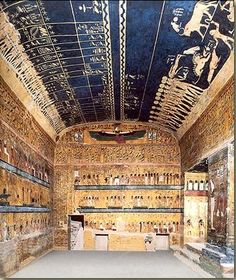
King Seti I is the second king of the Nineteenth Dynasty and the son of King Ramses I, father of the great King Ramses II. The name Seti means "of Set", which indicates that he was consecrated to the god Seth (god of evil). Seti I ruled the country for either 11 or 15 full Years. The Tomb of Seti I was discovered in October 1817 by the famous Italian Egyptologist Giovanni Battista Belzoni, and it was discovered only a few days, after the discovery of Seti I's father's tomb (KV 16). It is identified as KV 17, per Sir John Gardner Wilkinson's initial numbering system for the tombs of the Valley. Some people consider it as the most beautiful tomb in the Valley of the Kings as it is the most perfectly decorated tomb in the Valley of the Kings, with painted raised relief decoration of the highest quality. It is also the longest, deepest and most completely finished of all the tombs in the valley. The Tomb of Seti I consists of seven corridors and ten chambers. Its total area measures about 649.04 m², and its length is about 137.19 m². In the Burial Chamber of Seti I (KV 17), Belzoni found anthropoid calcite sarcophagus and fragment of canopic chest, now exhibited in the Soane Museum in London.
- The Architecture of the Tomb of Seti I (KV 17)
Generally, the Tomb of Seti I (KV 17) is decorated with scenes from the Litanies of Ra, the Imydwat, the Book of the Dead, Book of Gates, the Opening of the Mouth ritual, the Book of the Heavenly Cow, some astronomical scenes, as well as scenes of Sety I accompanied by different deities. We can notice many innovations in the architecture of this complicated tomb, for example, the structure of the burial chamber, with its vaulted ceiling and the well-shaft, and the two side chambers with pillars.
- Corridors B, D, G, and H of the Tomb of Seti I
Corridor B: In Corridor B, the walls are decorated with the Litanies of Ra which made its first appearance in a royal tomb. The King stands before god Ra-Horakhty on the left wall, followed by the "title page" of this text. Then the text itself continues, along with seventy-five invocations of the sun god. The text continues on the right wall. The ceiling is covered with decorations of birds whose heads are vultures or snakes. Corridor D: Much on these walls has been damaged; the fourth hour and the fifth hour of the Imydwat appear on the right wall and the left wall of Corridor D. There is black ink outlines mark the location of uncut recesses. When Belzoni first explored the tomb, the scenes were in almost perfect condition. Corridors G and H: The painted staircase leads down to Corridors G and H. The scenes in these corridors are taken from the Opening of the Mouth ritual, and show priests performing religious ceremonies. This is considered one of the best drawn representations of the Opening of the Mouth ceremony to be found in the Valley of the Kings, but much was destroyed by the nineteenth century visitors who took pieces away for shipment to European collectors.
- Chambers C, E, F, and I of the Tomb of Seti I Chamber C (
or the Stairwell) of the Tomb of Seti I: There is a large staircase cut in the floor of Stairwell C, followed by large recesses cut in the walls above. The walls of this chamber are decorated with the Litanies of Ra and the Imydwat. Above the rear door is a figure of Ma'at and the cartouches of Seti. After the recesses, there is a representation of Isis kneeling below a reclining Anubis jackal on the left wall, while Nephthys is depicted on the right. Chamber E of the Tomb of Seti I: At first, Chamber E was blocked with stone and brick. Then, it was covered with plaster and painted, in an attempt to frustrate tomb robbers. With a well shaft that measures 6.7 meters, Chamber E is covered with a row of figures showing the King being led by Harsiese and Isis, offering wine to Hathor, Osiris and the Mistress of the West. In the right half of the chamber, a seated figure of Osiris is followed by Anubis and Harsiese. The same scene is on the left side. Chamber F of the Tomb of Seti I: Chamber F is a four-pillared chamber, impressively decorated with scenes of the fifth and the sixth hour of the Book of Gates. We can see a quietly damaged scene at the left front corner of the chamber. It shows a row of western Asiatics, Nubians, Libyans, and Egyptians, dressed in traditional costume and wearing traditional hairstyles. A century ago, this scene was very well preserved and one of the most-remarkable scenes in this rich tomb. Around each pillar of the four pillars, we can see representations of the King standing with a variety of deities, Anubis, Ptah, Re-Horakhty, Hathor, Harsiese, Sokar, Atum, Nephthys, Neith, Shu, Isis and the Mistress of the west. Chamber I of the Tomb of Seti I: On the way to the Burial Chamber, we will pass by Chamber I, or what was called by Belzoni "the Hall of Beauties". It was so called due to its delicately-painted figures of the King with various deities. This chamber had been a masterpiece but, unfortunately, visitors of the nineteenth century seriously damaged the paint of the walls, as they were making copies of the wall by squeezing. The high quality of the relief carving can still be impressive, especially the tiny details of faces and hieroglyphs. On both the left and right side of the chamber, the King is shown seven times, with different deities, Hathor, Anubis, Isis, Harsiese, Osiris, Ptah and Nefertum.
- Side Chamber FA of the Tomb of Seti I
Noticeably, the scenes drawn in the Side Chamber FA of the Tomb of Seti I (KV 17) attest the skillfulness of the artisanship in this chamber. The scenes generally are from the ninth, tenth, and eleventh hours of the Imydwat. On the pillars, the King is shown standing with Nefertum, Ra-Horakhty, Ma'at, and Atum, Osiris, Hathor, and Sokar.
- Burial Chamber J of the Tomb of Seti I
The Burial Chamber of the Tomb of Seti I (KV 17) includes two sections: a front part with six pillars and a rear part with a lowered floor on which the alabaster sarcophagus, which once had the corpus of Seti I, sat beneath a magnificent vaulted ceiling. [This sarcophagus was removed to England and sold to a collector, and it is now displayed at Soane's Museum, London]. Unfortunately, the pillars of the lower section are damaged, one is missing; others were cut up and removed to museums in Europe. Generally, all of them showed the King with various deities, such as Iwnmutef, Ptah-Sokar, Ra-Hor-akhty, Geb, Osiris, Khepri, Thoth, Harsiese, Shu, Anubis, and the souls of Pe and Nekhen. On the side walls of the lower chamber, we can see winged figures of Isis and Nephthys, flanked by cartouches of King Seti I as well as scenes from the Imydwat on the left and the rear wall of the chamber. Moving to one of the most impressive scenes in the valley, which is the vaulted ceiling. In this part, you can obviously notice how the ancient artist perfectly done his work. This ceiling shows astronomical scenes, most of which still look obscure. In the upper pillared section, the walls show various texts and scenes from the Book of Gates.
- Side Chambers of the Burial Chamber of the Tomb of Seti I

Both the upper and lower parts of the Burial Chamber of KV 17 have Side Chambers, most of which are decorated with scenes from the Book of Gates. The left rear chamber has two pillars painted with figures of Osiris, and the walls are decorated with scenes from the seventh, the eighth and the ninth hours of the Imydwat. The first right-hand chamber houses scenes from the Book of the Heavenly Cow. In the lower part of Chamber J, a pit was dug in the floor, and into its rear wall, there is a small doorway. This doorway leads into a narrow carved tunnel extending about 100 meters at a steep downward angle into the bedrock. Some scholars believed that the Burial Chamber J is not the real burial place of King Seti I, but it is a false chamber meant to fool tomb robbers, and the real burial place is deep inside the mountain through the tunnel, and is still full of treasure. Other group of Egyptologists said that the tunnel was intended to join the burial of Seti I to ground water, and was similar to what Seti I had done in the Osirion at Abydos, where the "burial" of Osiris was symbolically joined to the primeval waters of creation.
